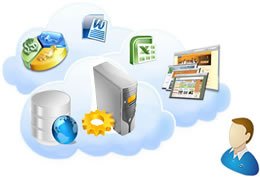Cloud Computing

The cloud computing , also known as cloud computing , of the English Cloud computing is a model or paradigm for the use of computing resources, which is completely based on Internet. These resources, which are normally software applications, but which can also be file storage, databases, email, etc., reside on remote servers, so that the user can access them from anywhere in the world, as long as have a browser and an internet connection.
The following video, originally from SalesForce, explains the concept of cloud computing in a clear and simple way :
Understanding the concept of cloud computing
Cloud ComputingCloud computing is a model of access to computer systems, in which data and applications are hosted on the Internet and in remote computing centers, in such a way that they can be used from any point that has  a network connection world. Cloud computing allows consumers and businesses to manage files and use programs, without having to install them locally on their computers. This technology offers a much more efficient use of resources, such as storage, memory, processing, and bandwidth.
a network connection world. Cloud computing allows consumers and businesses to manage files and use programs, without having to install them locally on their computers. This technology offers a much more efficient use of resources, such as storage, memory, processing, and bandwidth.
The term “cloud” is used as a metaphor for the Internet, and originates from the cloud used to represent the Internet in network diagrams, as an abstraction of the infrastructure it represents.
A simple example of cloud computing is the Google Docs / Google Apps electronic document and application system. For its use, it is not necessary to buy or install software or have a server, a broadband connection is enough to be able to use any of its services. The server and the management software are located in the cloud (Internet) and are directly managed by the service provider. In this way, it is much simpler for the consumer to enjoy the benefits. In other words: information technology becomes a service, which is consumed in the same way that we consume electricity or water.
In the past (and present), the traditional use of the PC has not changed much: We installed an operating system. After installing it, we look for applications (software), which we also install on our computer and which will allow us to perform different tasks. We therefore have Office applications (Word, Excel), design or photography applications (Photoshop, Illustrator), multimedia applications (Music Player, Videos). One could mention countless software that we download, install, and use. In contrast to the above, the idea of cloud computing is that, thanks to technological advances, we no longer need these applications to reside on our PC, since we can access similar services from the browser. Do you need to edit documents? There are alternatives such as Google Docs or Office 365, that offer us similar tools. Photo editing? There is Thumba or Pixlr. Music? They don’t even have to download or have the songs. These can live quietly in the cloud, and we can access the songs not only locally (from a computer), but we can do it from another PC, from our phone, or any other device connected to the web.
For common users
For us ordinary users, Cloud Computing is probably an everyday thing. Do you use Gmail, Hotmail, or any other online email service? So they are already using some form of Cloud Computing, where they have delegated the task previously carried out by applications, the famous email clients, to the browser.
And it is that little by little, the browser is becoming a kind of operating system, given the number of uses we give it. Have you ever thought about everything the browser can do? In the past, you just did that: surf the web. If we wanted to send a message to someone, we had to open a separate program. Send an email? Also an external program. Listen to music? The program that plays media.
What’s happening today? Today the browser is capable of encompassing all that. Music? There is Grooveshark, or the hundreds of similar services. Documents? You have surely tried Google Docs. Instant messaging? Why install programs, if we have Meebo, or eBuddy. Send e-mails? They probably have a tab open, right now, with Gmail or Hotmail open.
This is Cloud Computing for us common users. Little by little, many of the applications that in the past were “native” applications for Windows, Mac OS, or the operating system they are running, have already made the leap to the cloud, where they are totally independent of which system is accessing them. they. Which brings us to the other great advantage of having everything in the cloud: everything is portable.
In the past, saving an Office document meant that it ended up residing on our PC, because we keep it in our “My Documents” folder. With Cloud Computing, and taking the most common service, Google Docs, this article resides on the Internet. This not only means that we can access the file from any PC (as long as it has an internet connection), but also that we can view or edit it from our cell phone, laptop, iPad, or whatever they have on hand. And not only that: it is enough to give access to colleagues, and they will be able to view and edit the document with us, in real time. Do you have suggestions, or something that should be changed? They can simply do it, leaving a note of why they did it.

For the companies
For companies, the impact of Cloud Computing is even greater. Imagine you have a small business. Not only do they have to buy specific hardware that meets certain characteristics, but they also have to buy software (and licenses) for each of the PCs they will use. New personnel? They will need more licenses. Apart from this, specialized personnel will surely be required to maintain and update all hardware and software.
With cloud computing, or Cloud Computing, everything is centralized on the Web. This means that we can have a single application, running on a server, to which all workers have access, needing a single license, or perhaps renting it only for as long as it is needed.
A licensed copy of a word processor, for example, must reside on our PC to create the document. The program is worthless as long as the PC is off at night. Or worse still, the same employee may need another license to write or edit a document on their home PC, as they have to install it again on that PC. When implementing a “Cloud Computing” solution, these same documents, and even the entire application, would be available to this worker on his PC at home, just by opening the browser, entering his user data, and starting to edit the document. .
The idea of cloud computing also greatly reduces hardware implementation costs. For specialized software, it is no longer necessary to have the fastest PC in the West with outrageous amounts of RAM; It would be enough to have a relatively inexpensive PC that serves as a terminal, capable of simply running the necessary software to remotely interact with the web, which would take care of all this processing work.
Other scopes
The idea of Cloud Computing is spreading even further. Recently, the OnLive project was presented. The idea is the same, to centralize the processing and host everything on third-party servers, but this time, it is applied to video games. That’s right, instead of having to run games on our PC, OnLive runs it on their servers, and we manipulate it remotely. This means, of course, that we can run even the latest and greatest games without worrying about hardware limits. And this means that we can play a PC game, or an Xbox 360 game, or a Playstation 3 game, wherever we want, including on our own cell phones.
Uses and applications
Cloud computing can be applied in almost any environment: from the small merchant who needs an e-commerce website, quickly and cheaply, to the large companies, who want to reduce expenses and avoid the difficulties of managing a center complex computation.
Cloud computing services range from individual business applications, such as customer and contact manager, accounting and financial software or office software, to high-performance IT outsourcing for complex 3D designs, motion pictures or scientific research. .
The customer can at any time decide which applications to use and choose between those that are free and those that are not. In the case of paid applications, the cost will depend on various variables, such as the contracted service, the time that this service has been used, the volume of data traffic used, the number of users, etc.
Advantages of cloud computing
Fast : The most basic cloud services work on their own. For more complex database and software services, cloud computing allows you to skip the hardware acquisition phase and the associated expense, making it perfect for business start-ups.
Current : Most vendors constantly update their software, adding new features as soon as they are available.
Elastic : Quickly adaptable to growing businesses or seasonal peaks, as the cloud system is designed to cope with large increases in workload. This increases the agility of response, reduces risks and operational costs, because it only scales what grows and only pays for what you use.
Mobile : The cloud system is designed to be used remotely, so company staff will have access to most systems wherever they are.
Minimum investment : The provider offers services to several companies, which benefit from sharing a complex infrastructure and pay only for what they actually use.
Conclusions.
Everything indicates that cloud computing is an unstoppable technological trend, which is progressively but surely being adopted by companies of all kinds, especially SMEs. The predictions confirm that companies in our country have understood the great advantages of cloud computing and are willing to take advantage of this model to boost their corporate growth.






